Criterion for Unbounded Synchronous Region in Complex Networks
Abstract
Synchronization of complex networks has been extensively studied in many fields, where intensive efforts have been devoted to the understanding of its mechanisms. As for discriminating network synchronizability by Master Stability Function method, a dilemma usually encountered is that we have no prior knowledge of the network type that the synchronous region belongs to. In this paper, we investigate a sufficient condition for a general complex dynamical network in the absence of control. A main result is that, when the coupling strength is sufficiently strong, the dynamical network achieves synchronization provided that the symmetric part of the inner-coupling matrix is positive definite. According to our results, synchronous region of the network with positive definite inner-coupling matrix belongs to the unbounded one, and then the eigenvalue of the outer-coupling matrix nearest 0 can be used for judging synchronizability. Even though we cannot gain the necessary and sufficient conditions for synchronizing a network so far, our results constitute a first step toward a better understanding of network synchronization.
1. Introduction
Complex dynamical networks have received increasing attention from different fields in the past two decades. So far, the dynamics of complex networks has been extensively investigated, in which synchronization is a typical topic which has attracted lots of concern [1–17].
As an interesting phenomenon that enables coherent behavior in networks as a result of coupling, synchronization and the discussion upon its sufficient or necessary condition are fundamental and valuable. Pecora and his colleagues used the so-called Master Stability Function (MSF) approach to determine the synchronous region in coupled systems [18, 19], in which the negativeness of Lyapunov Exponent for master stability equation ensures synchronization. Combining MSF approach with Gershörin disk theory, Chen et al. imposed constraints on the coupling strengths to guarantee stability of the synchronous states in coupled dynamical network [20]. These methods, however, obtain just necessary conditions for synchronization due to the fact that Lyapunov Exponent is employed to judge the stability of system.
Zhou et al. and Li and Chen investigated synchronization in general dynamical networks by integrating network models and an adaptive technique and proved that strong enough couplings will synchronize an array of identical cells [11, 12]. To overcome the difficulties caused by too many controllers in large scale complex networks, pinning mechanism is further applied to analyze network synchronization criteria in the works by Zhou et al. and Chen et al. [13, 14]. Research studies on network synchronization mentioned above focused on sufficient conditions, but all of them are gained by introducing controllers.
For general complex dynamical networks in the absence of control, we investigate their sufficient conditions for achieving network synchronization in the current work. Using Lyapunov direct method [21, 22] and matrix theory [23–27], a criterion for synchronization in generally coupled identical systems is proposed. We conclude that network synchronization will be reached when the coupling strength is larger than a threshold, given that the symmetric part of the inner-coupling matrix is positive definite. It is analytically derived in our paper that a network belongs to Type I with respect to synchronized region [28], provided with a positive definite inner-coupling matrix.
For discriminating network synchronizability, it is well known that a dilemma is usually encountered in the process of applying MSF method. That is, we have no prior knowledge of the network type that the synchronous region belongs to. Stemmed from our results, the eigenvalue of the outer-coupling matrix nearest 0 can be used for judging synchronizability of a dynamical network with positive definite inner-coupling matrix. Even though we cannot gain the necessary and sufficient conditions for synchronizing a network so far, our results constitute a first step toward a better understanding of network synchronization.
The rest of the paper is organized as follows. In Section 2, a general complex dynamical network model and some mathematical preliminaries are introduced. A sufficient condition for achieving synchronization in the network and detailed discussion are presented in Section 3. Section 4 gives some numerical simulations to show the effectiveness of the proposed synchronization criterion and further illustrates the relationship between synchronous region and our main results. Conclusions are finally drawn in Section 5.
2. Preliminaries
Definition 1. Let be a solution of the complex dynamical network (1) with initial state . Assume that f : Ω → Rn is continuously differentiable, where Ω⊆Rn. If there is a nonempty subset E⊆Ω, with xi(t0) ∈ E (1 ≤ i ≤ N), such that xi(X0; t) ∈ Ω for all t ≥ t0, 1 ≤ i ≤ N and that
To develop the main results, a useful hypothesis on the inner-coupling matrix H is introduced.
Assumption 2. Suppose that μi > 0 (1 ≤ i ≤ n), with μ1, μ2, …, μn being eigenvalues of the symmetric part of the inner-coupling matrix Hs≜(H + H⊤)/2.
It suggests that Hs should be a positive definite matrix. This is common for the inner-coupling matrix H to satisfy μi > 0 (1 ≤ i ≤ n); for instance, the symmetric part Hs is strictly diagonally dominant.
Since A and Hs are symmetric, there exist orthogonal matrices P ∈ ℝN×N and Q ∈ ℝn×n, such that
Let ξ = (ξ1, ξ2, …, ξN) ⊤ be the left eigenvector of the coupling configuration matrix A corresponding to the eigenvalue λ1 = 0, in which . It is obvious that ξ⊤A = 0. Then introducing a weighted mean state of all nodes
Lemma 3. For any initial state X0 of model (1), network synchronization lim t→∞ ∥xi(t) − xj(t)∥ = 0 (1 ≤ i, j ≤ N) is equivalent to .
Proof. On one hand, provided with lim t→∞∥xi(t) − xj(t)∥ = 0 (1 ≤ i, j ≤ N), one obtains
On the other hand, if , one has . Owing to the fact that
Remark 4. Lemma 3 has proved that is a sufficient and necessary condition for network synchronization. In other words, the dynamics of all nodes in the complex network (1) would approach when network synchronization is reached.
Recently, it has been mathematically proved that is a solution of single node dynamical system in the sense of positive limit set [29]
Define the state error vectors as for all nodes in the network.
Then the error system is given by
Denote , , F(X) = (f(x1) ⊤, f(x2) ⊤, …, f(xN) ⊤) ⊤, and . Then one has
3. Main Results
In this section, a sufficient condition for reaching synchronization in a general complex dynamical network (1) is presented based on Lyapunov direct method and some related matrix theory. Further discussion of the synchronization criterion in detail is also included.
To deduce the sufficient condition for stability of system (13), the following assumption is one of the basic prerequisites.
Assumption 5. Suppose that there exists a positive constant ℒ > 0 satisfying ∥Df(·)∥ ≤ ℒ.
This hypothesis is achievable for a large class of systems depicted by , including linear systems, piecewise linear systems, and numerous chaotic systems (e.g., Chua’s circuit [30], Lorenz family [31–33], etc.).
Theorem 6. Suppose that Assumptions 2 and 5 hold. The synchronous solution of network (1) is asymptotically stable provided that c is larger than c0, where c0 = − ℒ/λ2min 1≤k≤n {μk}.
Proof. According to Lemma 3 and the previous discussion, asymptotical stability of synchronous solution of network model (1) can be analyzed by investigating the stability of system (13). Consider a positive semidefinite function as
In view of λi < 0 (2 ≤ i ≤ N) and μk > 0 (1 ≤ k ≤ n), the derivation of the Lyapunov candidate would be nonpositive given c > −ℒ/λ2min 1≤k≤n {μk}. The largest invariant set of is Ξ = {ζi = 0,2 ≤ i ≤ N}. According to LaSalle’s invariance principle [21], all the trajectories of system (13) will converge to Ξ asymptotically for any initial values. In this set, it is plain to see that ηi = 0 for 2 ≤ i ≤ N. That means system (13) is stable, and accordingly the synchronous solution of dynamical network (1) is asymptotically stable.
From Theorem 6, we conclude that whether can synchronization of a general complex dynamical network (1) be achieved depends on the relationship between the coupling strength c and the constant c0. The term c0 = −ℒ/λ2min 1≤k≤n {μk} is associated with individual node dynamics (ℒ), inner coupling (min 1≤k≤n{μk}), and topology structure (λ2) of the whole network.
Remark 7. The smaller the c0 is, the larger the coupling strength c which leads to network synchronization is. In detail, smaller ℒ of single node dynamics or larger min 1≤k≤n {μk} of inner-coupling matrix brings about better synchronizability for particular network topology.
Remark 8. It is worth noticing that although the previous result assumes that c > c0 = −ℒ/λ2 min 1≤k≤n {μk}, the threshold of c may be much smaller than c0 in reality. In other words, the synchronization criterion for dynamical network (1) is just a sufficient condition.
Remark 9. Theorem 6 reveals that for any topology structure, synchronization of network (1) can be achieved when the coupling strength c is strong enough, provided that Assumptions 2 and 5 hold. Further, it is seen that the synchronous region of dynamical network (1) belongs to Type I from the angle of Master Stability Function method [28] (see Section 4). Accordingly, the eigenvalue λ2 of the outer-coupling matrix nearest 0 can be used for judging synchronizability of networks.
Remark 10. Although our analysis is founded on a basic hypothesis that the complex network is bidirectionally coupled (the outer-coupling matrix A is symmetric), similar conclusions can be drawn for the case in which this hypothesis is relaxed to unidirectional network.
4. Numerical Simulations
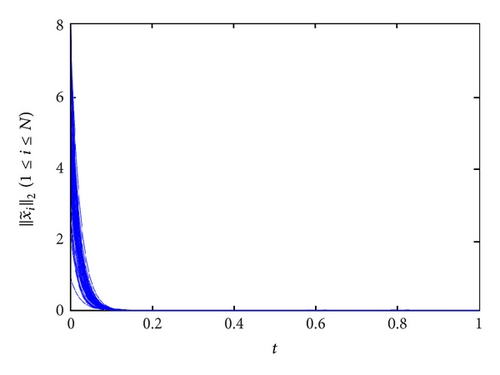

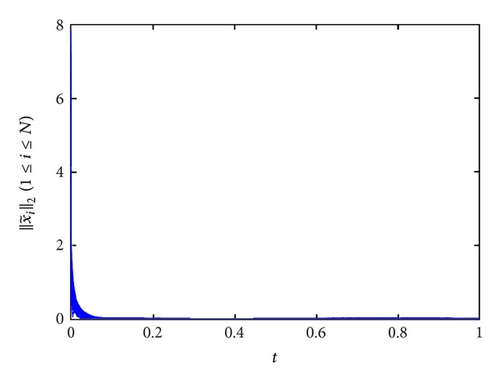
From Figure 1, three networks have all reached synchronization in the condition of c > c0, which are consistent with Theorem 6.
According to Remark 8, the condition c > c0 for network synchronization is just sufficient. To illustrate, let c be about 10% of the original coupling strength; say, c(GCN) = 0.1, c(SN) = 5, and c(LN) = 310. It is seen from Figure 2 that synchronization of three networks is achieved as well even if the synchronization criterion c > c0 is not guaranteed.
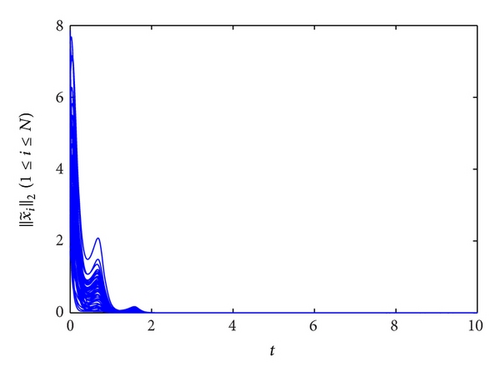
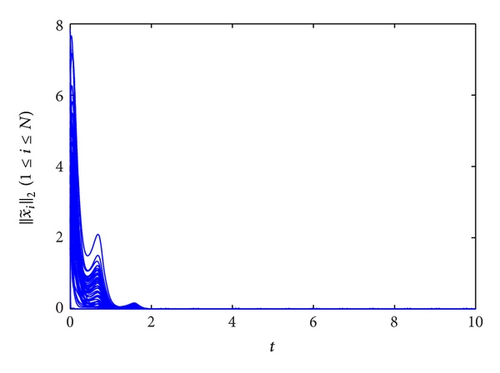
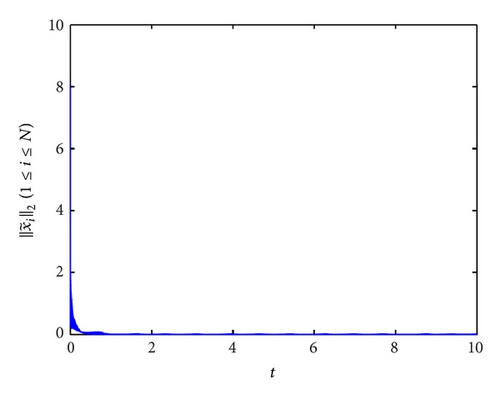
Theorem 6 reveals that if Assumptions 2 and 5 hold, synchronization of network (1) can be achieved provided that c is sufficiently large. In the case of network synchronization, the real number σ = −c λ falls into the synchronous region [28], where λ is any eigenvalue of the outer-coupling matrix A except λ1 = 0. Furthermore, in view of Theorem 6, the synchronous region of the network is unbounded, which belongs to Type I. If the network belongs to one of the other three types of synchronous region, the coupling strength c which leads to synchronization may be upper bounded or even nonexistent. To clarify the unboundedness of synchronous region for the qualified network, three inner-coupling matrices which satisfy Assumption 2 are employed. We choose Lorenz systems as the nodes in dynamical network (1) and coupled them through H1, H2, and H3. Let H1 = I, , and . It is easy to verify that the symmetric part of the inner-coupling matrices , , and is positive definite. Figure 3 shows the relationship between Lyapunov Exponents (LEs) of system (13) and σ = −cλ. During the growth of σ, LE of system (13) becomes negative when σ crosses a threshold , and accordingly system (13) is stable. In other words, if synchronization of network (1) is reached, the coupling strength c should be larger than a threshold . Predictably, is much weaker than c0 got from Theorem 6. Given coupling configuration structure of a dynamical network, the eigenvalues λi (1 ≤ i ≤ N) would be certain, and thus network (1) synchronization would ensure . This is in agreement with Remark 9. On the one hand, the exact threshold of coupling strength for network synchronization is smaller than c0 according to Theorem 6. On the other hand, that is larger than lies in the fact that leads to asynchronization. Although we cannot gain the exact value of so far, our results pave the way for exploring in depth the necessary and sufficient conditions of network synchronization.
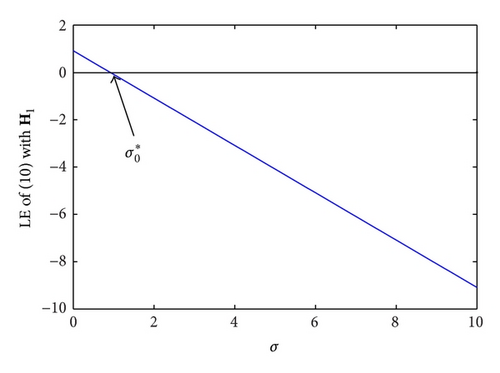
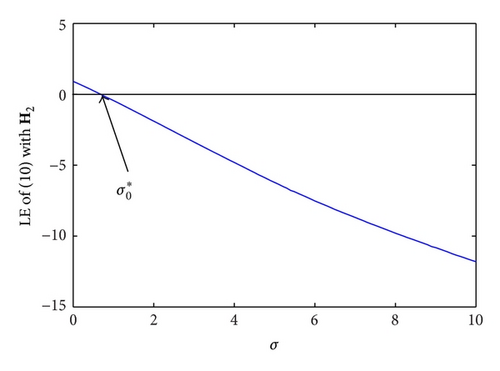
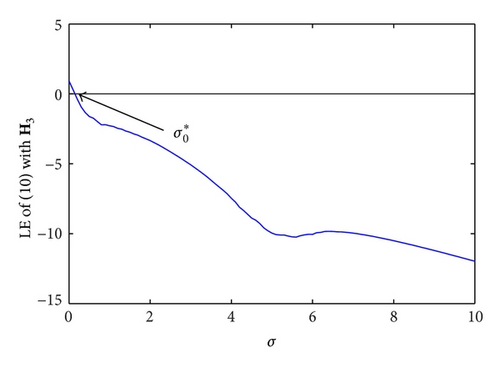
5. Conclusions
In conclusion, we have developed a sufficient condition for a general complex dynamical network in the absence of control. We have concluded that if the coupling strength c is larger than c0 = −ℒ/λ2min 1≤k≤n{μk}, synchronization will be reached in the network, where the symmetric part of the inner-coupling matrix Hs is positive definite. In the sense of Master Stability Function method, we have further illustrated that positive eigenvalues of Hs lead to Type I network with which synchronous region is unbounded. The findings show that the eigenvalue λ2 of the outer-coupling matrix nearest 0 can be used for exploring synchronizability of a dynamical network with positive definite inner-coupling matrix.
Conflict of Interests
The author declares that there is no conflict of interests regarding the publication of this paper.
Acknowledgment
This work is supported by the National Natural Science Foundation of China under Grants 61004096, 61374173, and 11172215.




